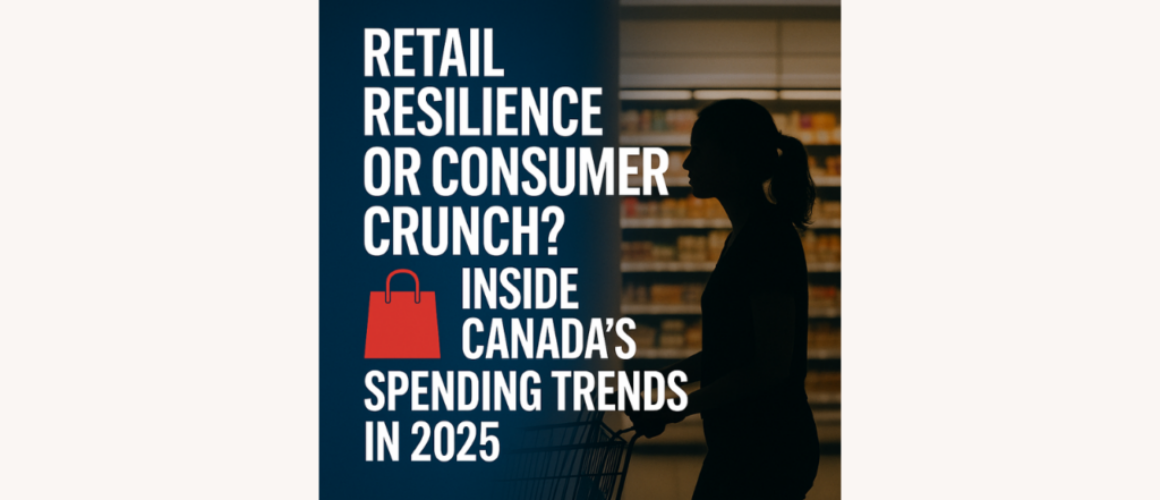Retail Resilience or Consumer Crunch? Inside Canada’s Spending Trends in 2025

Toronto, ON | Montreal, QC | Winnipeg, MB – Canadian retailers are walking a tightrope in 2025. On one side lies the lingering strength of post-pandemic demand; on the other, the chilling effects of high interest rates, persistent inflation in core goods, and a cautious consumer base. This tension has created a fractured retail landscape, where essentials remain resilient, but discretionary spending is eroding fast.
While total retail sales in Q1 grew a modest 0.8%, the composition of that growth reveals a widening gap in consumer behavior—a tale of two shoppers: those protecting essentials and those pulling back across all non-essentials.
Grocery and Essentials Still Hold Strong
Despite the broader slowdown, grocery chains, discount stores, and bulk retailers continue to outperform. Consumers, faced with food price inflation still hovering near 8%, have shifted spending to:
-
Private-label or store-brand goods
-
Value-packaged staples
-
Discount retailers like No Frills, Giant Tiger, and Dollarama
Retailers have responded by expanding house-brand offerings, introducing new app-based coupons, and investing in loyalty programs to retain price-sensitive customers.
Even major chains like Loblaw and Sobeys have begun offering multi-tiered loyalty systems, which combine digital engagement with in-store offers—creating a hybrid retail experience tailored for cautious shoppers.
Winners and Losers in Non-Essentials
The non-essential sector tells a different story:
-
Apparel & Fashion: National chains report declining foot traffic, with Q1 clothing sales down 6.4% year-over-year. Luxury brands are holding steady in metro areas, but mid-range apparel has been hit hardest.
-
Home Furnishings & Decor: A pandemic-fueled boom has faded. With housing transactions frozen, demand for renovations and new furnishings has dropped sharply.
-
Electronics: Consumer tech sales are holding, but upgrade cycles have lengthened, with fewer Canadians upgrading smartphones, laptops, or TVs in 2025.
Interestingly, experience-based retail—such as home gyms, outdoor gear, and travel goods—has seen modest growth, driven by middle-class households reallocating funds from real estate to lifestyle.
E-Commerce Plateaus, Hybrid Models Rise
Canada’s e-commerce sector, which grew by over 75% between 2019 and 2022, has now plateaued. Online sales account for 18.9% of total retail transactions, slightly down from their pandemic-era peak.
Retailers are investing instead in hybrid experiences:
-
In-store pick-up for online orders
-
Digital-first loyalty programs tied to mobile apps
-
Enhanced analytics for personalized in-store offers
Companies like Canadian Tire and Sport Chek are leading the charge with integrated app-store experiences that blur the line between digital and physical retail.
Household Budget Pressures
Several macroeconomic pressures continue to reshape consumer spending:
-
High interest rates are straining credit card usage and installment purchases, especially among Gen Z and millennial households
-
Housing costs, particularly rent, are eating into discretionary income in urban centers
-
Job uncertainty in tech, manufacturing, and construction has pushed many consumers into precautionary saving mode
In a recent consumer confidence survey, 67% of Canadians said they plan to reduce spending on non-essentials over the next 6 months.
Retailers Adjust: Leaner Inventories, Targeted Promotions
Retailers are responding by:
-
Reducing inventory purchases to avoid overstock
-
Focusing marketing on value messaging and limited-time discounts
-
Slowing store expansions, especially in Tier 2 markets
-
Doubling down on data-driven promotions and cross-selling within loyalty ecosystems
Retail executives are cautiously optimistic that a Q4 rebound could emerge if the Bank of Canada signals clear movement on interest rate reductions and consumer confidence improves.
The Takeaway: A Market in Transition
Canada’s retail economy in 2025 is no longer about rapid growth—it’s about strategic adaptation. From consumer psychology to product sourcing, everything is shifting to reflect a new reality: Canadian households are becoming more selective, value-driven, and digital-savvy.
For businesses, the winners will be those who listen, pivot, and personalize. The rest may find themselves cut from a shrinking consumer wallet.